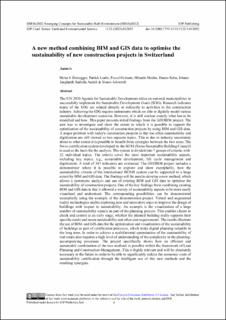Please use this identifier to cite or link to this item:
https://doi.org/10.21256/zhaw-27266Full metadata record
| DC Field | Value | Language |
|---|---|---|
| dc.contributor.author | Bernegger, Heinz J. | - |
| dc.contributor.author | Laube, Patrick | - |
| dc.contributor.author | Ochsner, Pascal | - |
| dc.contributor.author | Meslec, Mihaela | - |
| dc.contributor.author | Rahn, Hanno | - |
| dc.contributor.author | Junghardt, Johann | - |
| dc.contributor.author | Aurich, Isabella | - |
| dc.contributor.author | Ashworth, Simon | - |
| dc.date.accessioned | 2023-03-11T11:02:57Z | - |
| dc.date.available | 2023-03-11T11:02:57Z | - |
| dc.date.issued | 2022-12-22 | - |
| dc.identifier.issn | 1755-1307 | de_CH |
| dc.identifier.issn | 1755-1315 | de_CH |
| dc.identifier.uri | https://digitalcollection.zhaw.ch/handle/11475/27266 | - |
| dc.description.abstract | Dieses Papier präsentiert erste Erkenntnisse aus dem GEOBIM-Projekt. Ziel war es zu untersuchen und aufzuzeigen, inwieweit es möglich ist, die Optimierung der Nachhaltigkeit von Bauprojekten durch den Einsatz von BIM- und GIS-Daten zu unterstützen. Die Erkenntnisse werden genutzt, um eine neue Methode zu entwickeln, die eine systematische Analyse und Nutzung vorhandener BIM- und GIS-Daten zur Optimierung der Nachhaltigkeit von Bauprojekten ermöglicht. Eine der wichtigsten Erkenntnisse aus der Kombination bestehender BIM- und GIS-Daten ist, dass eine Vielzahl von Nachhaltigkeitsaspekten einfacher visualisiert und verstanden werden konnten. So können Bauherren frühzeitig prüfen und kontrollieren, ob das geplante Gebäude wirklich ihre spezifischen Bedürfnisse unterstützt und Nachhaltigkeits- und andere Nutzeranforderungen erfüllt. Die Ergebnisse veranschaulichen die Nutzung von BIM- und GIS-Daten zur Optimierung und Visualisierung der Nachhaltigkeit von Gebäuden im Rahmen von Zertifizierungsprozessen, die die digitale Planung langfristig wertvoll machen. Um eine multifaktorielle Optimierung der Nachhaltigkeit von Immobilien zu erreichen, bedarf es auch eines hohen Verständnisses für die Komplexität in den planungsbegleitenden Prozessen. Das Projekt zeigt konkret, wie eine effiziente und nachhaltige Kombination der beiden Methoden im Rahmen von Lean Planning and Construction Management möglich ist. Dies ist von hoher Relevanz und zukünftig zwingend erforderlich, um durch den intelligenten Einsatz dieser neuen Methoden und die daraus resultierenden Synergien die volkswirtschaftlichen Kosten einer Nachhaltigkeitszertifizierung deutlich reduzieren zu können. | de_CH |
| dc.language.iso | en | de_CH |
| dc.publisher | IOP Publishing | de_CH |
| dc.rights | https://creativecommons.org/licenses/by/3.0/ | de_CH |
| dc.subject | Nachhaltigkeitszertifizierung | de_CH |
| dc.subject | GIS | de_CH |
| dc.subject | BIM | de_CH |
| dc.subject | GeoBIM | de_CH |
| dc.subject.ddc | 338.927: Umweltökonomie und nachhaltige Entwicklung | de_CH |
| dc.title | A new method combining BIM and GIS data to optimise the sustainability of new construction projects in Switzerland | de_CH |
| dc.type | Konferenz: Paper | de_CH |
| dcterms.type | Text | de_CH |
| zhaw.departement | Life Sciences und Facility Management | de_CH |
| zhaw.organisationalunit | Institut für Facility Management (IFM) | de_CH |
| zhaw.organisationalunit | Institut für Umwelt und Natürliche Ressourcen (IUNR) | de_CH |
| dc.identifier.doi | 10.1088/1755-1315/1122/1/012052 | de_CH |
| dc.identifier.doi | 10.21256/zhaw-27266 | - |
| zhaw.conference.details | SBEfin2022 Emerging Concepts for Sustainable Built Environment, online, 23-25 November 2022 | de_CH |
| zhaw.funding.eu | No | de_CH |
| zhaw.originated.zhaw | Yes | de_CH |
| zhaw.pages.start | 012052 | de_CH |
| zhaw.publication.status | publishedVersion | de_CH |
| zhaw.volume | 1122 | de_CH |
| zhaw.publication.review | Peer review (Publikation) | de_CH |
| zhaw.title.proceedings | IOP Conference Series: Earth and Environmental Science | de_CH |
| zhaw.webfeed | Geoinformatik | de_CH |
| zhaw.webfeed | Immobilienmanagement | de_CH |
| zhaw.webfeed | Real Estate Management (IFM) | de_CH |
| zhaw.funding.zhaw | GeoBIM Campus N IUNR | de_CH |
| zhaw.author.additional | No | de_CH |
| zhaw.display.portrait | Yes | de_CH |
| Appears in collections: | Publikationen Life Sciences und Facility Management | |
Files in This Item:
| File | Description | Size | Format | |
|---|---|---|---|---|
| 2022_Bernegger-etal_BIM-GIS-data-to-optimise-sustainability-in-construction-projects-CH.pdf | 728.85 kB | Adobe PDF |  View/Open |
Show simple item record
Bernegger, H. J., Laube, P., Ochsner, P., Meslec, M., Rahn, H., Junghardt, J., Aurich, I., & Ashworth, S. (2022). A new method combining BIM and GIS data to optimise the sustainability of new construction projects in Switzerland [Conference paper]. IOP Conference Series: Earth and Environmental Science, 1122, 12052. https://doi.org/10.1088/1755-1315/1122/1/012052
Bernegger, H.J. et al. (2022) ‘A new method combining BIM and GIS data to optimise the sustainability of new construction projects in Switzerland’, in IOP Conference Series: Earth and Environmental Science. IOP Publishing, p. 012052. Available at: https://doi.org/10.1088/1755-1315/1122/1/012052.
H. J. Bernegger et al., “A new method combining BIM and GIS data to optimise the sustainability of new construction projects in Switzerland,” in IOP Conference Series: Earth and Environmental Science, Dec. 2022, vol. 1122, p. 012052. doi: 10.1088/1755-1315/1122/1/012052.
BERNEGGER, Heinz J., Patrick LAUBE, Pascal OCHSNER, Mihaela MESLEC, Hanno RAHN, Johann JUNGHARDT, Isabella AURICH und Simon ASHWORTH, 2022. A new method combining BIM and GIS data to optimise the sustainability of new construction projects in Switzerland. In: IOP Conference Series: Earth and Environmental Science. Conference paper. IOP Publishing. 22 Dezember 2022. S. 012052
Bernegger, Heinz J., Patrick Laube, Pascal Ochsner, Mihaela Meslec, Hanno Rahn, Johann Junghardt, Isabella Aurich, and Simon Ashworth. 2022. “A New Method Combining BIM and GIS Data to Optimise the Sustainability of New Construction Projects in Switzerland.” Conference paper. In IOP Conference Series: Earth and Environmental Science, 1122:12052. IOP Publishing. https://doi.org/10.1088/1755-1315/1122/1/012052.
Bernegger, Heinz J., et al. “A New Method Combining BIM and GIS Data to Optimise the Sustainability of New Construction Projects in Switzerland.” IOP Conference Series: Earth and Environmental Science, vol. 1122, IOP Publishing, 2022, p. 12052, https://doi.org/10.1088/1755-1315/1122/1/012052.
Items in DSpace are protected by copyright, with all rights reserved, unless otherwise indicated.